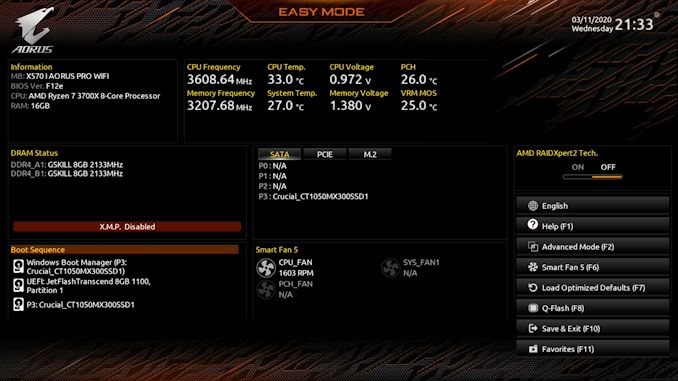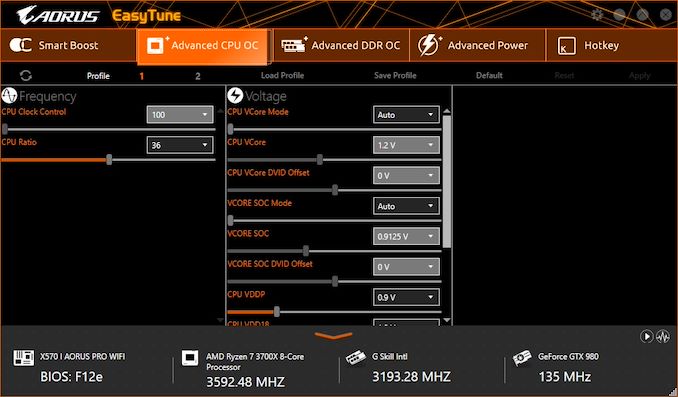On The Wings of an Eagle: GIGABYTE's X570 I Aorus Pro WIFI Motherboard Tested
by Gavin Bonshor on March 19, 2020 10:00 AM ESTBIOS
GIGABYTE's firmware features two primary modes, basic and advanced. Even from the GIGABYTE X570 Aorus Xtreme model which is its flagship X570 board, the firmware throughout the range seems consistent. The GUI of the firmware consists of a black background, orange highlights and white text.
Along the top of the advanced mode is five primary menus including Tweaker, Settings, System Info, Boot, and Save & Exit. The GIGABYTE Aorus BIOS also includes the Smart Fan 5 utility which allows users to create custom fan profiles for the two 4-pin headers onboard, with a Q-Flash utility to allow users to update the board's firmware.
The GIGABYTE Aorus firmware is easy to navigate, with a very basic array of menus and options for users to select from. The firmware itself is responsive and we didn't experience any instability or input lag. Users looking to overclock will find plenty of settings available for tweaking including CPU, power, voltage and memory-related settings. There aren't quite as many overclocking settings as models such as the MSI MEG X570 Godlike, especially in terms of memory latency settings, but the GIGABYTE Aorus firmware looks good and works well.
Software
With many vendors starting to switch from including bundles of software utilities to condensing them into one primary package, GIGABYTE has opted to stick with its usual range of applications for the X570 series. All of the software applications operate around its GIGABYTE App Center utility, with this acting as a general hub not only for GIGABYTE applications but Windows and third-party applications too.
The stand-out applications available on the driver and software installation disc bundled with the X570 I Aorus Pro WIFI include the RGB Fusion 2.0 software, the EasyTune overclocking utility, and the @BIOS software.
GIGABYTE offers users plenty of avenues to update the board's firmware with the @BIOS software, as well as the Q-Flash button which allows users to update the BIOS without a CPU or memory installed in the box. This is a huge plus point for users offering multiple avenues to make system critical firmware updates. The RGB Fusion software gives users the ability to customize RGB LED lighting via a range of different lighting effects, while the EasyTune utility allows users to monitor the system and do overclocking within the software. It's not as extensive as AMD's Ryzen Master utility and doesn't offer as many options as the latter. For those looking to enhance the auditory experience with the integrated Realtek ALC1220 HD audio codec, users will need to download the Realtek Audio Control Center direct from the Microsoft store as only the core audio drivers are supplied on disc.
























63 Comments
View All Comments
InTheMidstOfTheInBeforeCrowd - Friday, March 20, 2020 - link
Hahaha, LOL... and respect, quite impressive. Makes me remember the old "Into the Shadows" demo from Triton (https://www.youtube.com/watch?v=kSRGLapSx3w).umano - Friday, March 20, 2020 - link
I really hope next x670 boards will support 2 m2 pcie at full speed, thunderbolt and 10gbe, at least on dtx size. I know I am dreaming but this is what I would really buyDug - Friday, March 20, 2020 - link
I wish you would test the parts of the motherboard that count, like networking, usb, sound, storage. Common Anantech. Get back to good reviews.It's getting old testing the same benchmarks that don't make any difference to users as they are all within a small percentage of each other.
qit - Saturday, March 21, 2020 - link
"same power stages that the flagship GIGABYTE X570 Aorus Xtreme is using, albeit in a smaller package with fewer phases."Does a power delivery stage with significant less phases (6 vs 16) actually qualify as "the same"?
Or is this more like a way of writing that wouldn't have appeared on anandtech years ago?
HardwareDufus - Saturday, March 28, 2020 - link
This looks like it could be my next motherboard. Would like it if it had optical audio (SPDIF), but that's okay.HardwareDufus - Saturday, March 28, 2020 - link
Dual M.2 and Dual HDMI is a very thoughful combination! So many folks like two harddrives and use two monitors...MetaCube - Tuesday, March 31, 2020 - link
Dual M.2 are quite popular, but that would be great if MB manufacturers could fuck off with video outputs.Qasar - Tuesday, March 31, 2020 - link
only way for that to happen, is if amd/intel made 2 product lines, cpu and motherboard, from top to bottom.watzupken - Monday, March 30, 2020 - link
I was considering getting this board together to be used with the 4xxx series APU later in the year, while using it with a 3400G. However one thing that I don't like is the sharing of the heatsink between the NVME drive and chipset. I guess there is very limited space to separate these 2, but I don't think its an ideal solution. I read on Amazon reviews that the SSD temps get quite high as a result. And yeah, not too thrilled with the idea of active cooling on the motherboard since it can be another point of failure.ForNein - Tuesday, April 7, 2020 - link
I'm confused.There is a complaint on page two about the lack of an M2 thermal pad on the chipset heatsink and then in the final picture and description you mention the inclusion of an M2 thermal pad.